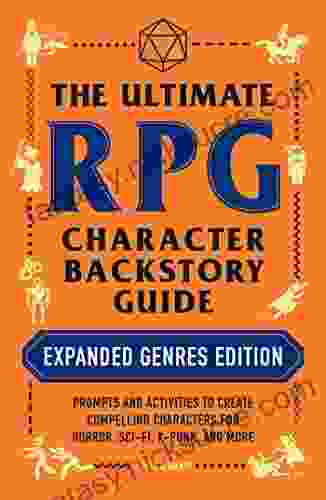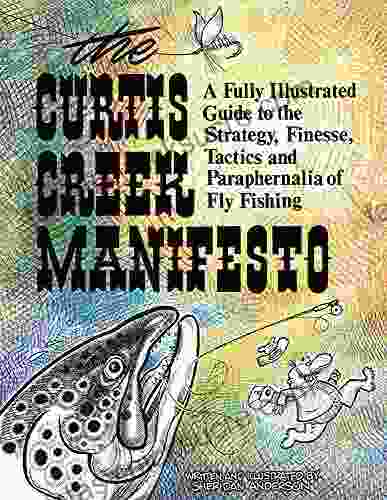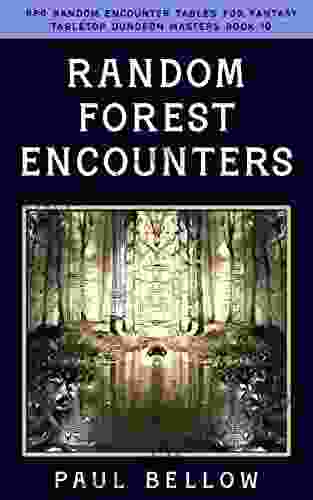Fully Illustrated Guide to the Strategy, Finesse, Tactics, and Paraphernalia of Fly Fishing

Fly fishing is a challenging and rewarding sport that requires skill, patience, and a deep understanding of the fish you're trying to catch. This fully illustrated guide will teach you everything you need to know to get started, from choosing the right gear to mastering the techniques of casting, retrieving, and landing a fish.
4.7 out of 5
| Language | : | English |
| File size | : | 6338 KB |
| Screen Reader | : | Supported |
| Print length | : | 48 pages |
| Lending | : | Enabled |
Chapter 1: Getting Started
This chapter will introduce you to the basics of fly fishing, including the different types of gear, the different techniques of casting, and the different types of flies. You'll also learn how to choose the right gear for your needs and how to care for your gear.
Section 1: Choosing the Right Gear
The first step to getting started with fly fishing is choosing the right gear. There are a lot of different factors to consider, such as the type of fish you're trying to catch, the water conditions, and your budget. This section will help you choose the right rod, reel, line, and flies for your needs.
Rods
The rod is the most important piece of gear in fly fishing. It's what you use to cast the line and retrieve the fish. Rods come in a variety of lengths, weights, and actions. The length of the rod will determine how far you can cast. The weight of the rod will determine how much line it can handle. The action of the rod will determine how it flexes when you cast and retrieve. For beginners, a 9-foot, 5-weight rod with a medium action is a good all-around choice.
Reels
The reel is what you use to store the line and fight the fish. Reels come in a variety of sizes and styles. The size of the reel will determine how much line it can hold. The style of the reel will determine how it operates. For beginners, a simple single-action reel is a good choice.
Line
The line is what you use to connect the rod to the fly. Lines come in a variety of weights and tapers. The weight of the line will determine how far it can be cast. The taper of the line will determine how it sinks in the water. For beginners, a weight-forward floating line is a good choice.
Flies
Flies are what you use to attract and catch fish. Flies come in a variety of shapes, sizes, and colors. The type of fly you use will depend on the type of fish you're trying to catch, the water conditions, and the time of year. For beginners, a few basic flies, such as the Wooly Bugger, the Hare's Ear Nymph, and the Adams Dry Fly, are a good place to start.
Section 2: Learning the Techniques of Casting
Once you have the right gear, it's time to learn the techniques of casting. Casting is the process of using the rod to launch the line and fly into the water. There are a variety of different casting techniques. The most basic casting technique is the overhead cast. This is the easiest casting technique to learn and it's a good all-around choice for most situations. Once you have mastered the overhead cast, you can learn other casting techniques, such as the roll cast and the side cast.
The Overhead Cast
The overhead cast is the most basic casting technique. It is performed by holding the rod in one hand and the line in the other hand. The rod is held behind the head and the line is held in front of the body. The rod is then swung forward and the line is released. The line will fly through the air and land on the water.
Section 3: Mastering the Techniques of Retrieving
Once you have cast the line, it's time to retrieve it. Retrieving is the process of using the rod and reel to bring the line and fly back to you. There are a variety of different retrieving techniques. The most basic retrieving technique is the straight retrieve. This is the simplest retrieving technique to learn and it's a good all-around choice for most situations. Once you have mastered the straight retrieve, you can learn other retrieving techniques, such as the strip retrieve and the twitch retrieve.
The Straight Retrieve
The straight retrieve is the most basic retrieving technique. It is performed by simply reeling in the line. The rod is held in one hand and the reel is turned with the other hand. The line will be retrieved at a constant speed.
Section 4: Landing a Fish
Once you have hooked a fish, it's time to land it. Landing a fish is the process of bringing the fish to the boat or shore and removing the hook from its mouth. There are a variety of different landing techniques. The most basic landing technique is the hand landing. This is the simplest landing technique to learn and it's a good all-around choice for most situations. Once you have mastered the hand landing, you can learn other landing techniques, such as the net landing and the gaff landing.
The Hand Landing
The hand landing is the most basic landing technique. It is performed by simply grabbing the fish by the mouth and lifting it out of the water. The fish is then held in one hand while the hook is removed with the other hand.
Chapter 2: Advanced Techniques
Once you have mastered the basics of fly fishing, you can start to learn some advanced techniques. These techniques can help you catch more fish, in more challenging conditions. This chapter will teach you about some of the most popular advanced fly fishing techniques, such as nymphing, streamer fishing, and dry fly fishing.
Section 1: Nymphing
Nymphing is a technique that involves fishing with a fly that imitates a nymph. Nymphs are the immature stage of aquatic insects. They live on the bottom of the river or lake and feed on algae and other small organisms. Nymphing can be a very effective way to catch fish, especially in cold water or when the fish are not rising to the surface.
Section 2: Streamer Fishing
Streamer fishing is a technique that involves fishing with a fly that imitates a small fish or baitfish. Streamer fishing can be very effective way to catch fish, especially in fast-moving water or when the fish are feeding on baitfish.
4.7 out of 5
| Language | : | English |
| File size | : | 6338 KB |
| Screen Reader | : | Supported |
| Print length | : | 48 pages |
| Lending | : | Enabled |
Do you want to contribute by writing guest posts on this blog?
Please contact us and send us a resume of previous articles that you have written.
 Fiction
Fiction Non Fiction
Non Fiction Romance
Romance Mystery
Mystery Thriller
Thriller SciFi
SciFi Fantasy
Fantasy Horror
Horror Biography
Biography Selfhelp
Selfhelp Business
Business History
History Classics
Classics Poetry
Poetry Childrens
Childrens Young Adult
Young Adult Educational
Educational Cooking
Cooking Travel
Travel Lifestyle
Lifestyle Spirituality
Spirituality Health
Health Fitness
Fitness Technology
Technology Science
Science Arts
Arts Crafts
Crafts DIY
DIY Gardening
Gardening Petcare
Petcare Dave Pine
Dave Pine Nrup Parikh
Nrup Parikh Henry Nicholls
Henry Nicholls James Alexander Currie
James Alexander Currie Robert Bruce Thompson
Robert Bruce Thompson Rupert Spira
Rupert Spira Cheryl Marlene
Cheryl MarleneR E S
 R E Skibiski
R E Skibiski Kevin C Kelleher Md Md
Kevin C Kelleher Md Md Maggi Savin Baden
Maggi Savin Baden Sandra Davidson
Sandra Davidson Kevin Marx
Kevin Marx Tiffany Loggins Psyd
Tiffany Loggins Psyd Bill Patton
Bill Patton Steve Schwartz
Steve Schwartz Ofer Gal
Ofer Gal Martyn Denscombe
Martyn Denscombe Matthew Bowling
Matthew Bowling Joseph Campbell
Joseph Campbell Susan M Orsillo
Susan M Orsillo Dan Yaccarino
Dan Yaccarino Steven Hassan
Steven Hassan Joann Cianciulli
Joann Cianciulli Stephan A Hoeller
Stephan A Hoeller Tony Ortega
Tony Ortega Claudia Mazzucco
Claudia Mazzucco David Halberstam
David Halberstam Evan Purcell
Evan Purcell Silvia Dunn
Silvia Dunn Charles Duhigg
Charles Duhigg D C Haenlien
D C Haenlien Justin Lichter
Justin Lichter Sang H Kim
Sang H Kim Robert P Beebe
Robert P Beebe Stephen Arterburn
Stephen Arterburn Craig Chappelow
Craig Chappelow C D Holmes Miller
C D Holmes Miller Rod Powers
Rod Powers Jane Bottomley
Jane Bottomley Vanessa Lapointe
Vanessa Lapointe David E Stuart
David E Stuart Ryan Johnston
Ryan Johnston Neil D Jespersen
Neil D Jespersen Christian Smith
Christian Smith Tara Bianca
Tara Bianca Gavin Weightman
Gavin Weightman Emma Griffin
Emma Griffin Richard Holmes
Richard Holmes Russ Harris
Russ Harris Simon Buxton
Simon Buxton Robert F Burgess
Robert F Burgess Bill Hammack
Bill Hammack Ramona Finn
Ramona Finn Special Tactics
Special Tactics Cj Andersen
Cj Andersen Doug Scott
Doug Scott Marie Max House
Marie Max House Shelby Mahurin
Shelby Mahurin Kate Darling
Kate Darling Frank Giampaolo
Frank Giampaolo Cherie Dimaline
Cherie Dimaline Dr Julissa Hernandez Nd Cnhp
Dr Julissa Hernandez Nd Cnhp Frederica Relly
Frederica Relly Clement Salvadori
Clement Salvadori Erin Mckittrick
Erin Mckittrick S W Wilcox
S W Wilcox Jamie Foxx
Jamie Foxx Editors Of Sports Illustrated
Editors Of Sports Illustrated John Brierley
John Brierley Sara Low
Sara Low Megan Mcgrory Massaro
Megan Mcgrory Massaro Victoria Johnson
Victoria Johnson Joshua Foer
Joshua Foer Jojo Siwa
Jojo Siwa Blaine Bartel
Blaine Bartel Rachna Chhachhi
Rachna Chhachhi Joan Roughgarden
Joan Roughgarden Sue Enquist
Sue Enquist Chris Fischer
Chris Fischer Susan Shelby Torrance
Susan Shelby Torrance Jackie Brown
Jackie Brown Chris Napier
Chris Napier Jessica Wiebe
Jessica Wiebe Yossi Ghinsberg
Yossi Ghinsberg Jen Castleberry
Jen Castleberry Matt Parker
Matt Parker Ginger Sinsabaugh
Ginger Sinsabaugh Sheila Mackechnie Murtha
Sheila Mackechnie Murtha Bryan Irwin
Bryan Irwin Ezekiel Eversand
Ezekiel Eversand Melissa Abramovitz
Melissa Abramovitz T Edward Nickens
T Edward Nickens Nancy Romita
Nancy Romita Michael Volkmar
Michael Volkmar Phil Robertson
Phil Robertson Jeff Wheeler
Jeff Wheeler Chris Ferrie
Chris Ferrie Oscar Nilson
Oscar Nilson Felicity Aston
Felicity Aston Paula Yoo
Paula Yoo David Nirenberg
David Nirenberg Jeffrey Lindsey
Jeffrey Lindsey Vernon G Zunker
Vernon G Zunker Marion Zimmer Bradley
Marion Zimmer Bradley David Benjamin
David Benjamin Laurence Price
Laurence Price Dan Blanchard
Dan Blanchard Nicole R Taylor
Nicole R Taylor Megan Don
Megan Don Dr Nancy L Nolan
Dr Nancy L Nolan Lee Gutkind
Lee Gutkind Harlan Coben
Harlan Coben Leah Day
Leah Day Meagan Trayler
Meagan Trayler Emma Cannon
Emma Cannon Michael D Alessio
Michael D Alessio Hayley Mitchell Haugen
Hayley Mitchell Haugen Virginia Smith Harvey
Virginia Smith Harvey Stephen L Morgan
Stephen L Morgan Sheridan Anderson
Sheridan Anderson Rachel Burgess
Rachel Burgess Henry M Cowles
Henry M Cowles Carl B Tolman
Carl B Tolman Greg Witt
Greg Witt Linda Bauer
Linda Bauer Elizabeth King
Elizabeth King James W Finegan
James W Finegan Carolyn Schulz
Carolyn Schulz Terry Pratchett
Terry Pratchett Bill Streever
Bill Streever Manoj Sharma
Manoj Sharma Gary Dean Quesenberry
Gary Dean Quesenberry Bob Duff
Bob Duff Gary Player
Gary Player Jake Jacobson
Jake Jacobson Yau Ming Ng Thompson
Yau Ming Ng Thompson Fiona Danks
Fiona Danks Ross Bonander
Ross Bonander Karyn D Hall
Karyn D Hall Margo Armstrong
Margo Armstrong Wanza Leftwich
Wanza Leftwich Eric H Cline
Eric H Cline Jacques Devore
Jacques Devore Helen Irlen
Helen Irlen Kevin Sverduk
Kevin Sverduk Kenny Dill
Kenny Dill Bob Duchesne
Bob Duchesne Robert Axelrod
Robert Axelrod Beck Weathers
Beck Weathers Bev Pettersen
Bev Pettersen Elizabeth A Stanley
Elizabeth A Stanley David Joyce
David Joyce Elizabeth Winthrop
Elizabeth Winthrop General
General Patrick Mcginty
Patrick Mcginty Deborah Blum
Deborah Blum Tom Humphrey
Tom Humphrey Dawn Hadley
Dawn Hadley Holger Schutkowski
Holger Schutkowski J Douglas Faires
J Douglas Faires Ellen Schuthof Lesmeister
Ellen Schuthof Lesmeister Michael J Tougias
Michael J Tougias Colleen Graves
Colleen Graves Jane Nelsen
Jane Nelsen Bill Miller
Bill Miller Brad States
Brad States Luciano Floridi
Luciano Floridi Jonathan Crichton
Jonathan Crichton Bill Moeller
Bill Moeller Clifford A Pickover
Clifford A Pickover Edwin H Friedman
Edwin H FriedmanMax Youngquist
 Elizabeth Thompson
Elizabeth Thompson Kasey Edwards
Kasey Edwards Stephanie Manley
Stephanie Manley Zach Schonbrun
Zach Schonbrun Marilee Lebon
Marilee Lebon Donncha Hanna
Donncha Hanna Olivia Gordon
Olivia Gordon Charles A Rhodus
Charles A Rhodus John H Holland
John H Holland Hilary Nangle
Hilary Nangle Douglas W Ota
Douglas W Ota Callum Roberts
Callum Roberts Gianna Sobol
Gianna Sobol Laurie Rubin
Laurie Rubin Bryan Mann
Bryan Mann Paris Williams
Paris Williams Peter Jackson
Peter Jackson Karen Armstrong
Karen Armstrong J D Gauchat
J D Gauchat Christopher Banecks
Christopher Banecks John Kettle
John Kettle Leland Chant
Leland Chant Mark Vanhoenacker
Mark Vanhoenacker Sandra Berenbaum
Sandra Berenbaum Marc Bona
Marc Bona Herschel Knapp
Herschel Knapp Michael Hartman
Michael Hartman Pat Drake
Pat Drake Tina Cassidy
Tina Cassidy Daniel J Velleman
Daniel J Velleman Michael Lempert
Michael Lempert Michael Sullivan
Michael Sullivan Jessica Taylor
Jessica Taylor Sharon Bergen
Sharon Bergen Curvebreakers
Curvebreakers Farah Heron
Farah Heron Brandon Sanderson
Brandon Sanderson Shantel Silbernagel
Shantel Silbernagel Erin Mcrae
Erin Mcrae Kat Kruger
Kat Kruger P J E Peebles
P J E Peebles Wendy Hinman
Wendy Hinman Gary Nicol
Gary Nicol Larry Baush
Larry Baush Jelena Bogdanovic
Jelena Bogdanovic Izzy Judd
Izzy Judd The Uk Mathematics Trust
The Uk Mathematics Trust Phoebe Bailey
Phoebe Bailey Sanford Holst
Sanford Holst Elsevier
Elsevier Jessica Denay
Jessica Denay David Price
David Price J T Williams
J T Williams Rebekah Nathan
Rebekah Nathan Mark Booth
Mark Booth H P Lovecraft
H P Lovecraft Jon M Sweeney
Jon M Sweeney David E Johnson
David E Johnson Kristopher Martel
Kristopher Martel Marsha Vanwynsberghe
Marsha Vanwynsberghe Dan Murphy
Dan Murphy Joy Hakim
Joy Hakim Pedro Urvi
Pedro Urvi Bharath Ramsundar
Bharath Ramsundar Thomas Bailey
Thomas Bailey Brienne Murk
Brienne Murk Ken Venturi
Ken Venturi Janice Selekman
Janice Selekman Hugh Neill
Hugh Neill Dick Edie
Dick Edie Rabbi Jason Sobel
Rabbi Jason Sobel Peter Julius Sloan
Peter Julius Sloan Chris Sims
Chris Sims J Robert King
J Robert King Pete Spencer
Pete Spencer Kiera Cass
Kiera Cass Michael J Epstein
Michael J Epstein Robert A Pelcovits
Robert A Pelcovits Jamie Dumas
Jamie Dumas Kent Hrbek
Kent Hrbek Michael Matthews
Michael Matthews Paul Francis
Paul Francis Curt Sampson
Curt Sampson Jeremy Paxman
Jeremy Paxman Sarah Zettel
Sarah Zettel Tony Guerra
Tony Guerra Mark Lehner
Mark Lehner Scott Wilson
Scott Wilson Bob Glover
Bob Glover Irene Mceachen
Irene Mceachen Laura Nowlin
Laura Nowlin Marty Gitlin
Marty Gitlin Bode Miller
Bode Miller Paul Brummell
Paul Brummell Jared Derksen
Jared Derksen Ernest Raymond
Ernest Raymond Dinah Bucholz
Dinah Bucholz Scarlett Curtis
Scarlett Curtis Zigzag English
Zigzag English Richard B Pelzer
Richard B Pelzer Eric A Weiss Md
Eric A Weiss Md Enzo Tonti
Enzo Tonti Dylan Tomine
Dylan Tomine Ta Nehisi Coates
Ta Nehisi Coates Michael W Eysenck
Michael W Eysenck Lynette Rushton
Lynette Rushton Gregg Jackson
Gregg Jackson Jacques Steinberg
Jacques Steinberg Ingrid Chalufour
Ingrid Chalufour G William Barnard
G William Barnard Claire Russell
Claire Russell Isabel Fonseca
Isabel Fonseca Dean Keith Simonton
Dean Keith Simonton Mindy Mcginnis
Mindy Mcginnis Mike Westerfield
Mike Westerfield Joe Byers
Joe Byers Jon Loeliger
Jon Loeliger Carlos Castaneda
Carlos Castaneda James Patterson
James Patterson Henry Charles Lea
Henry Charles Lea Robert Byron
Robert Byron Ian Tuhovsky
Ian Tuhovsky John Mccannon
John Mccannon Jim Greenwood
Jim Greenwood Jakub Marian
Jakub Marian Sara Dyer
Sara Dyer Sabaa Tahir
Sabaa Tahir George C Thomas
George C Thomas Thomas Cleary
Thomas Cleary Jarrett Dapier
Jarrett Dapier Diondre Mompoint
Diondre Mompoint Bill Gutman
Bill Gutman George Mahood
George Mahood Betsy Herman
Betsy Herman Diana Wynne Jones
Diana Wynne Jones Stacie Mahoe
Stacie Mahoe Bill Karwin
Bill Karwin Richard W Fisher
Richard W Fisher Stanislas Dehaene
Stanislas Dehaene Jennifer Kolari
Jennifer Kolari Marcus Brotherton
Marcus Brotherton Holly Donahue Singh
Holly Donahue Singh Frank S Ring
Frank S Ring John C Norcross
John C Norcross James R Payne
James R Payne Matt Doeden
Matt Doeden Richard Post
Richard Post Andrea Cremer
Andrea Cremer Rob Steger
Rob Steger Alan Lawrence Sitomer
Alan Lawrence Sitomer Davi Kopenawa
Davi Kopenawa Daniele Benedettelli
Daniele Benedettelli Bill Boyum
Bill Boyum Melissa Layne
Melissa Layne William F Keegan
William F Keegan Heather Long
Heather Long Robert Greene
Robert Greene Louis Sachar
Louis Sachar Tom Dodd
Tom Dodd Martin Davies
Martin Davies Rob Casey
Rob Casey Lucas Bessire
Lucas Bessire Bjorn Kiggen
Bjorn Kiggen Holly Jackson
Holly Jackson Issai Chozanshi
Issai Chozanshi Lisa Dorfman
Lisa Dorfman John Muir Laws
John Muir Laws Elliot Kay
Elliot Kay Gail Fay
Gail Fay Max Help Workbooks
Max Help Workbooks Helen Clarke
Helen Clarke Bill Nowlin
Bill Nowlin Erin Beaty
Erin Beaty Fred H Croom
Fred H Croom Manly P Hall
Manly P Hall Vukota Boljanovic
Vukota Boljanovic Sue L Hamilton
Sue L Hamilton Tim Weston
Tim Weston Richard Rohr
Richard Rohr Jennifer Shannon
Jennifer Shannon Suzannah Rowntree
Suzannah Rowntree Jamie Aten
Jamie Aten Thad Beery
Thad Beery Sam Harris
Sam Harris Supersummary
Supersummary Rick Reilly
Rick Reilly Zane Grey
Zane Grey Joshua Becker
Joshua Becker Paul Halpern
Paul Halpern Valeria Ray
Valeria Ray Simon Baron Cohen
Simon Baron Cohen Billy Griffiths
Billy Griffiths Sharmila Desai
Sharmila Desai Mary Griffith
Mary Griffith Dan Garner
Dan Garner John Mccollister
John Mccollister Joie Jager Hyman
Joie Jager Hyman Ron Elbe
Ron Elbe Bill Bennett
Bill Bennett Linda D Dahl
Linda D Dahl Sandi Mann
Sandi Mann Pat Cohen
Pat Cohen Billy Martin
Billy Martin Ross Edgley
Ross Edgley Ted Kaczynski
Ted Kaczynski Geraldine Van Bueren
Geraldine Van Bueren Al Walsh
Al Walsh Kindle Edition
Kindle Edition Shawn Levy
Shawn Levy Mike Gibson
Mike Gibson Dashka Slater
Dashka Slater Peter Aitken
Peter Aitken Editors Of Garden And Gun
Editors Of Garden And Gun Jedd K Parkinson
Jedd K Parkinson Aylette Jenness
Aylette Jenness Paul Levy
Paul Levy Styrling Strother
Styrling Strother Karen Palacios Jansen
Karen Palacios Jansen Doug Fletcher
Doug Fletcher Charlie Craven
Charlie Craven Phil Genova
Phil Genova Tiffany Bergin
Tiffany Bergin Simon Pridmore
Simon Pridmore Katie Singer
Katie Singer Marisa Imon
Marisa Imon Adiba Jaigirdar
Adiba Jaigirdar Ian Wilson
Ian Wilson Kasun Indrasiri
Kasun Indrasiri Genius Reads
Genius Reads Dina Nayeri
Dina Nayeri T Whitmore
T Whitmore Blake Sebring
Blake Sebring Herbert Dorsey
Herbert Dorsey Mike Veny
Mike Veny Gary Kamiya
Gary Kamiya Dan Hamilton
Dan Hamilton Chris Sajnog
Chris Sajnog Freddie Fernandez
Freddie Fernandez Max Lugavere
Max Lugavere Zavonda Vinson Parrish
Zavonda Vinson Parrish Mosby
Mosby Rocky Mcelveen
Rocky Mcelveen Bex Gunn
Bex Gunn Rick Steves
Rick Steves Krista Tippett
Krista Tippett Jitendra Chouksey
Jitendra Chouksey Shannon Sovndal
Shannon Sovndal Anya Kamenetz
Anya Kamenetz Deborah J Rumsey
Deborah J Rumsey Michael Tlanusta Garrett
Michael Tlanusta Garrett Kristin N Spencer
Kristin N Spencer Kate Marchant
Kate Marchant Mark Solms
Mark Solms Morgan Oostra
Morgan Oostra Charles Goodwill
Charles Goodwill Jacqueline B Persons
Jacqueline B Persons James Dashner
James Dashner Steve Biddulph
Steve Biddulph Mercedes Lackey
Mercedes Lackey Brian Crist
Brian Crist Zecharia Sitchin
Zecharia Sitchin James P Allen
James P Allen Dawn Huebner
Dawn Huebner Rachael Scdoris
Rachael Scdoris Yakima Canutt
Yakima Canutt Conway X Bowman
Conway X Bowman Marie Viljoen
Marie Viljoen Steven M Levy
Steven M Levy Carlos Torres
Carlos Torres Zoe Hana Mikuta
Zoe Hana Mikuta Wendy Doniger
Wendy Doniger Fodor S Travel Guides
Fodor S Travel Guides Charlotte E English
Charlotte E English Carson Sievert
Carson Sievert Charles Simpson
Charles Simpson Jackie Bolen
Jackie Bolen Bill Gladstone
Bill Gladstone Colin Thubron
Colin Thubron Sophia Freeman
Sophia Freeman Joseph Edminister
Joseph Edminister Bill Schneider
Bill Schneider Paul Bellow
Paul Bellow Gwendoline Smith
Gwendoline Smith Rough Guides
Rough Guides Mark Young
Mark Young
Light bulbAdvertise smarter! Our strategic ad space ensures maximum exposure. Reserve your spot today!

 Italo Calvino21 Ways To Eat The Elephant: A Comprehensive Guide to Tackling Overwhelming...
Italo Calvino21 Ways To Eat The Elephant: A Comprehensive Guide to Tackling Overwhelming...
 John GrishamPrompts and Activities to Create Compelling Characters for Horror, Sci-Fi,...
John GrishamPrompts and Activities to Create Compelling Characters for Horror, Sci-Fi,... Gilbert CoxFollow ·9k
Gilbert CoxFollow ·9k Ismael HayesFollow ·18k
Ismael HayesFollow ·18k Roberto BolañoFollow ·7.6k
Roberto BolañoFollow ·7.6k Cameron ReedFollow ·18.5k
Cameron ReedFollow ·18.5k Mitch FosterFollow ·5k
Mitch FosterFollow ·5k Dallas TurnerFollow ·11.2k
Dallas TurnerFollow ·11.2k Tyrone PowellFollow ·3.4k
Tyrone PowellFollow ·3.4k Jamie BellFollow ·4.3k
Jamie BellFollow ·4.3k

 Sammy Powell
Sammy PowellBalancing Your Hormones Naturally: Regaining Fertility...
Hormones play a vital role in our...

 Kendall Ward
Kendall WardThe Other Baby Book: A Comprehensive Guide to Baby's...
The Other Baby...

 Kenneth Parker
Kenneth ParkerA Comprehensive Guide to Yoga Sadhana for Mothers:...
Motherhood is a...

 Neil Parker
Neil ParkerInside the Secret Space Programs
An Exposé...
4.7 out of 5
| Language | : | English |
| File size | : | 6338 KB |
| Screen Reader | : | Supported |
| Print length | : | 48 pages |
| Lending | : | Enabled |












